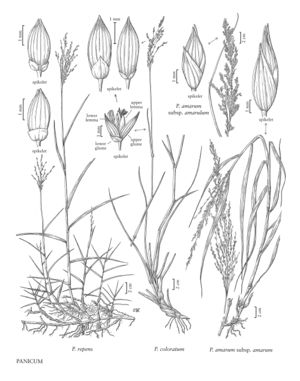Difference between revisions of "Panicum amarum subsp. amarum"
FNA>Volume Importer |
FNA>Volume Importer |
||
| Line 12: | Line 12: | ||
}}<!-- | }}<!-- | ||
| − | --><span class="statement" id="st-undefined" data-properties=""><b>Plants </b>with horizontally elongated rhizomes, internodes mostly over 1 cm, scales not overlapping. <b>Culms</b> 20-150 cm, solitary and erect or somewhat bunched and decumbent at the base, often branching from the lower nodes. <b>Panicles</b> often less than 5 cm wide, spikelet density less than in subsp. amarulum; primary branches solitary or paired, often strongly scabrous, with secondary and tertiary branches. <b>Spikelets</b> 4.7-7.7 mm. <b>Lower</b> glumes with 7-9 prominent veins, midvein scabridulous distally.</span><!-- | + | --><span class="statement" id="st-undefined" data-properties=""><b>Plants </b>with horizontally elongated rhizomes, internodes mostly over 1 cm, scales not overlapping. <b>Culms</b> 20-150 cm, solitary and erect or somewhat bunched and decumbent at the base, often branching from the lower nodes. <b>Panicles</b> often less than 5 cm wide, spikelet density less than in <i></i>subsp.<i> amarulum</i>; primary branches solitary or paired, often strongly scabrous, with secondary and tertiary branches. <b>Spikelets</b> 4.7-7.7 mm. <b>Lower</b> glumes with 7-9 prominent veins, midvein scabridulous distally.</span><!-- |
-->{{Treatment/Body | -->{{Treatment/Body | ||
| − | |discussion=<p>Panicum amarum subsp. amarum grows on foredunes, where its longer rhizomes probably permit it to respond quickly to being buried under shifting sand, and occasionally in the swales with subsp. amarulum. It ranges farther north (into Connecticut) than subsp. amarulum, but apparently not into Mexico, Cuba, or the Bahamas. It includes both tetraploids and hexaploids, and is partially sterile. Hybridization with P. virgatum may have had some role in its origin.</p> | + | |discussion=<p><i>Panicum amarum </i>subsp.<i> amarum</i> grows on foredunes, where its longer rhizomes probably permit it to respond quickly to being buried under shifting sand, and occasionally in the swales with <i></i>subsp.<i> amarulum</i>. It ranges farther north (into Connecticut) than <i></i>subsp.<i> amarulum</i>, but apparently not into Mexico, Cuba, or the Bahamas. It includes both tetraploids and hexaploids, and is partially sterile. Hybridization with <i>P. virgatum</i> may have had some role in its origin.</p> |
|tables= | |tables= | ||
|references= | |references= | ||
| Line 35: | Line 35: | ||
|publication year= | |publication year= | ||
|special status= | |special status= | ||
| − | |source xml=https://jpend@bitbucket.org/aafc-mbb/fna-data-curation.git/src/ | + | |source xml=https://jpend@bitbucket.org/aafc-mbb/fna-data-curation.git/src/8f726806613d60c220dc4493de13607dd3150896/coarse_grained_fna_xml/V25/V25_1265.xml |
|subfamily=Poaceae subfam. Panicoideae | |subfamily=Poaceae subfam. Panicoideae | ||
|tribe=Poaceae tribe Paniceae | |tribe=Poaceae tribe Paniceae | ||
Revision as of 17:29, 18 September 2019
Plants with horizontally elongated rhizomes, internodes mostly over 1 cm, scales not overlapping. Culms 20-150 cm, solitary and erect or somewhat bunched and decumbent at the base, often branching from the lower nodes. Panicles often less than 5 cm wide, spikelet density less than in subsp. amarulum; primary branches solitary or paired, often strongly scabrous, with secondary and tertiary branches. Spikelets 4.7-7.7 mm. Lower glumes with 7-9 prominent veins, midvein scabridulous distally.
Discussion
Panicum amarum subsp. amarum grows on foredunes, where its longer rhizomes probably permit it to respond quickly to being buried under shifting sand, and occasionally in the swales with subsp. amarulum. It ranges farther north (into Connecticut) than subsp. amarulum, but apparently not into Mexico, Cuba, or the Bahamas. It includes both tetraploids and hexaploids, and is partially sterile. Hybridization with P. virgatum may have had some role in its origin.
Selected References
None.
